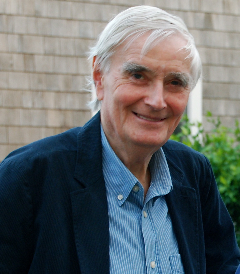Budd Hopkins, American artist and UFO researcher, died from liver cancer he was 80.
Budd Hopkins was an American painter, sculptor, and prominent figure in abduction phenomenon, and related UFO research died from liver cancer he was 80.
(June 15, 1931 – August 21, 2011 )
Life
Born in 1931 and raised in Wheeling, West Virginia. He graduated from Oberlin College in 1953, that same year moving to New York City, where he lived until his death in 2011.[3]
Hopkins’ art is in the permanent collections in the Whitney Museum, the Guggenheim Museum, Hirshhorn Museum, and at the Museum of Modern Art; he received grants or endowments from the Guggenheim Foundation and the National Endowment for the Arts. His articles on art appeared in magazines and journals, and he lectured at many art schools, including Truro Center for the Arts at Castle Hill.
Interest in UFOs
In 1964, Hopkins and two others reported seeing a UFO in daylight for several minutes[4]. Fascinated, Hopkins joined the now-defunct UFO research group National Investigations Committee On Aerial Phenomena (NICAP) and began reading many UFO books and articles.
In 1975, Hopkins and Ted Bloecher studied a multiple-witness UFO report, the North Hudson Park UFO sightings, which occurred in New Jersey[5]. In 1976, the Village Voice printed Hopkins’ account of the investigation.
Hopkins began receiving regular letters from other UFO witnesses, including a few cases of what would later be called “missing time” — inexplicable gaps in one’s memory, associated with UFO encounters.
Alien abduction
With Bloecher and psychologist Aphrodite Clamar, Hopkins began
investigating the missing time experiences, and eventually came to
conclude that the missing time cases were due to alien abduction.
By the late 1980s, Hopkins was one of the most prominent people in
ufology, earning a level of mainstream attention that was nearly
unprecedented for the field. He established the non-profit Intruders
Foundation 1989 to publicize his research.
Hopkins wrote several popular books about abductees, notably Missing Time, and was the founder of the Intruders Foundation, a non-profit organization created to document and research alien abductions, and to provide support to abductees.
For roughly the first seven years of his investigation of the
abduction phenomenon, Hopkins himself conducted no hypnosis sessions.
Rather, he secured the aid of licensed professionals. He noted that
three of these therapists (Drs. Robert Naiman, Aphrodite Clamar and Girard Franklin)
were quite skeptical of the reality of abduction claims, yet all
“uncovered” detailed abduction scenarios from their patients. (Hopkins,
218)
The 1992 made-for-television film Intruders was based on Hopkins’ research, and portrayed abduction scenes. Additionally, Hopkin’s 1996 book, Witnessed,
portrays a classic abduction case that was alleged to have occurred in
late 1989 near the Brooklyn Bridge in New York City. This case is unique
in that it is one of the first publicized episodes that involved
multiple abductees (who did not previously know each other) that come to
know each other in the “real” world through a variety of circumstances
connected to their abductions. Additionally, this case involved
inter-generational abductions within the same family.
Criticism
Controversy was a persistent feature of Hopkins’ career in alien
abduction and UFO studies. While few seemed to doubt Hopkin’s motives or
sincerity, critics charged that Hopkins was out of his element when he
used hypnosis, thereby aiding his subjects in confabulation —
the blending of fact and fantasy. However, Hopkins insisted such
criticism is specious. He wrote, “I have often frequently invited
interested therapists, journalists and academics to observe hypnosis sessions. Theoretical psychologist Nicholas Humphrey, who has held teaching positions at both Oxford and Cambridge Universities, and psychiatrist Donald. F. Klein, director of research at the New York State Psychiatric Institute and professor of psychiatry at the College of Physicians and Surgeons, Columbia University,
are but two of those who have observed my work firsthand. None of these
visitors … have reported anything that suggested I was attempting to
lead the subjects.” (Hopkins, 238-239)
To see more of who died in 2011 click here
